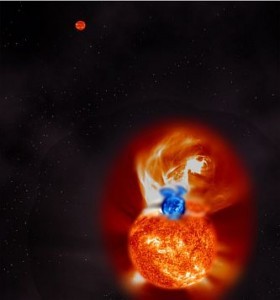The Wild Life of Aging Stars (and Planets): Leaving home, exchanging partners, and taking part in violent collisions
 Scientists from Technion and the University of Colorado, Boulder have taken a closer look at how stars systems and their planets grow old together.
Scientists from Technion and the University of Colorado, Boulder have taken a closer look at how stars systems and their planets grow old together.
The influence of stellar aging on systems composed of three stars in orbit about each other is particularly intriguing. Binary stars systems where one of the stars is orbited by a planet, react similarly to stellar maturation. Stars and planets in these systems can change orbital partners. In some cases, they may even collide or be expelled from the star system all together. This wild and turbulent scenario may have produced of the brightest star system in the sky, Sirius A and B. These findings raise the possibility that collisions between stars are more common (at least 30 times over) than conventional wisdom has shown.
Most stars either live a solitary existence, or pair up with one other star to make a binary system. However 15 percent of all stars orbit at least two other stars, forming a triple star system. Similarly, planets can be “hosted” by a binary system, which then behave much like a triple star system except that one object is vastly smaller than the other two. The evolution of stars in these systems can generate dramatic outcomes. The aging process of stars involves many major changes: a star can expand to a circumference greater than hundreds of times its original size, and then lose most of its mass in intense winds. At the end of this process the stellar core, a white dwarf, is all that is left behind. While much work has been devoted to understanding the evolution of single and binary star systems, studies on the evolution of triple stars are novel As is evident in the most recent research of Prof. Hagai Perets from the Faculty of Physics at Technion University, and Dr. Kaitlin Kratter from CU-Boulder, triple-star systems and their evolution are deserving of more interest. “Binary stars are systems that are generally stable,” says Perets. “The triple-star systems, on the other hand, are much more fragile,” and thus susceptible to disruption.
When mass is lost from one star during the ageing process, all of the orbits in the system change. These changes can induce dynamical instability, driving the system into a wild dynamic ‘dance,’ whereby the stars exchange partners until one of them gets expelled from the system altogether. Because the mass losing star begins to swell as it ages, it becomes a large target, significantly increasing its chances of crashing into another star in the midst of its wild ‘dance.’
Ordinarily, stars only collide in dense star clusters (systems with millions of stars packed into a volume of only a few cubic light years; for comparison, within the same volume in the neighbourhood of the Solar system there is only one star – the sun). Even in these dense clusters, the probability of a collision is very low.
“We discovered that when it comes to triple star systems, there is a different picture all together. Star collisions outside of dense star clusters can occur at a rate of 30 times higher in comparison to those coincidental collisions that occur within star clusters,” says Perets.
An answer to a Sirius mystery
According to Perets and Kratter, this type of chaotic evolution may be relevant to one of the best known stars, Sirius – the brightest star in the sky. Sirius is accompanied by a white dwarf in a binary system, but on a very eccentric orbit. This configuration is unusual for a star in a close orbit to a white dwarf; astronomers normally expect such orbits to be nearly circular, due to the exchange of mass between the stars as they age. The most recent findings show that this strange configuration may be explained if the Sirius binary system is the remnant of a triple system that became unstable and lost a star. “This surprising revelation that the triple evolution scenario we studied could solve the decades old mystery related to our brightest night-time star, Sirius, is very exciting; it appears that Sirius had a much wilder history than we could have ever imagined,” adds Perets.
Planetary “star-hoppers”
What would you do if your neighbourhood started to deteriorate? Would you consider moving to a better neighbourhood? It seems as if planets might make the same decision. Kratter and Perets also investigated systems where one of the three elements is not a star but a planet. Much like the case with three stars, mass loss by the planet-host can drive the planet into an unstable, chaotic orbit. The outcome, says Kratter, is surprising. “A planet can actually change which star it orbits, bouncing back and forth between the two.” Sometimes, such a star-hopper will settle down into a new, stable orbit around the companion star. More often, this story has an unhappy ending. It is more likely that the planet will collide with one of the two stars during its voyages between the two. Such a collision would obliterate the planet.


